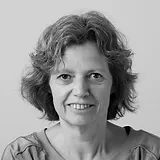
Anke van den Berg
prof. dr.
I work as a clinical molecular biologist in the department of Pathology. In this function I supervise and implement advanced molecular diagnostic techniques. Within my research line, I focus on the molecular pathogenesis of B-cell Hodgkin and non-Hodgkin lymphoma. The specific fields of interest are genomic aberrations, genetic susceptibility, and the role of small and long noncoding RNAs. I have several international collaborations and am PI and co-PI in various projects.
Lymphoma Research Groningen
In the University Medical Center Groningen research in the field of lymphoma is mainly clustered in the LRG. Members of the LRG are a mix of clinicians and basic scientists of five departments. These include Hematology, Medical Imaging Center, Pathology, Radiotherapy as well as the Trial data center.The lymphoma research is embedded within the ‘Stem cells, Ageing, Leukemia and Lymphoma’ (SALL) program. This program is one of the four main research programs of the Cancer Research Center Groningen (CRCG). Moreover, the work of the LRG is embedded in...
UNMASK
In collaboration with Games for health Europe we designed a citizen science game to let the gernal public help us with the identification of miRNA targets for important lymphoma associated miRNAs. See UNMASK.NL
Joost Kluiver (Photographer), A. van den Berg (Photographer)
Microenvironment, cross-talk, and immune escape mechanisms
Published in: Hematologic Malignancies
Access to document
10.1007/978-3-030-32482-7_4
document
Hodgkin lymphoma is a unique malignancy in which reactive immune cells vastly outnumber the tumor cells. The microenvironment is essential in many different aspects of Hodgkin lymphoma biology and has ramifications for diagnosis, clinical presentation, and therapeutic options. In this chapter we review current knowledge on the Hodgkin lymphoma microenvironment. Its composition is highly variable and provides the basis for diagnostic subtyping. T cells are virtually always present and usually cluster together with the tumor cells in so-called rosettes. We describe mechanisms by which the tumor cells actively...
WEE1 inhibition synergizes with CHOP chemotherapy and radiation therapy through induction of premature mitotic entry and DNA damage in diffuse large B-cell lymphoma
Published in: Therapeutic advances in hematology
Access to document
10.1177/2040620719898373
document
Background: Diffuse large B-cell lymphoma (DLBCL) is a heterogeneous disease, characterized by high levels of genomic instability and the activation of DNA damage repair pathways. We previously found high expression of the cell cycle regulator WEE1 in DLBCL cell lines. Here, we investigated the combination of the WEE1 inhibitor, AZD1775, with cyclophosphamide, doxorubicin, vincristine and prednisone (CHOP) and radiation therapy (RT), with the aim of improving first-line treatment. Methods: Cell viability experiments were performed to determine synergistic combinations. Levels of DNA damage were established using flow cytometry for...
Mathilde R. W. de Jong, Myra Langendonk, Bart Reitsma, Pien Herbers, Monique Lodewijk, Marcel Nijland, Anke van den Berg, Emanuele Ammatuna, Lydia Visser, Tom van Meerten
Primary and acquired resistance mechanisms to immune checkpoint inhibition in Hodgkin lymphoma
Published in: CANCER TREATMENT REVIEWS
Access to document
10.1016/j.ctrv.2019.101931
document
Hodgkin lymphoma is a B cell derived malignancy characterized by a low number of tumor cells within an environment consisting of inflammatory cells. Recently, immune checkpoint blockade targeting the PD-1-PD-L1 axis has shown to be a great success in relapsed and refractory Hodgkin lymphoma patients. However, complete responses are scarce and median progression-free survival is limited to around 11-15 months. Efficiency of PD-1 blockade in HL might be dependent on CD4 + T cells, but also tumor associated macrophages (TAMs) and NK cells are implicated. The aim of...
